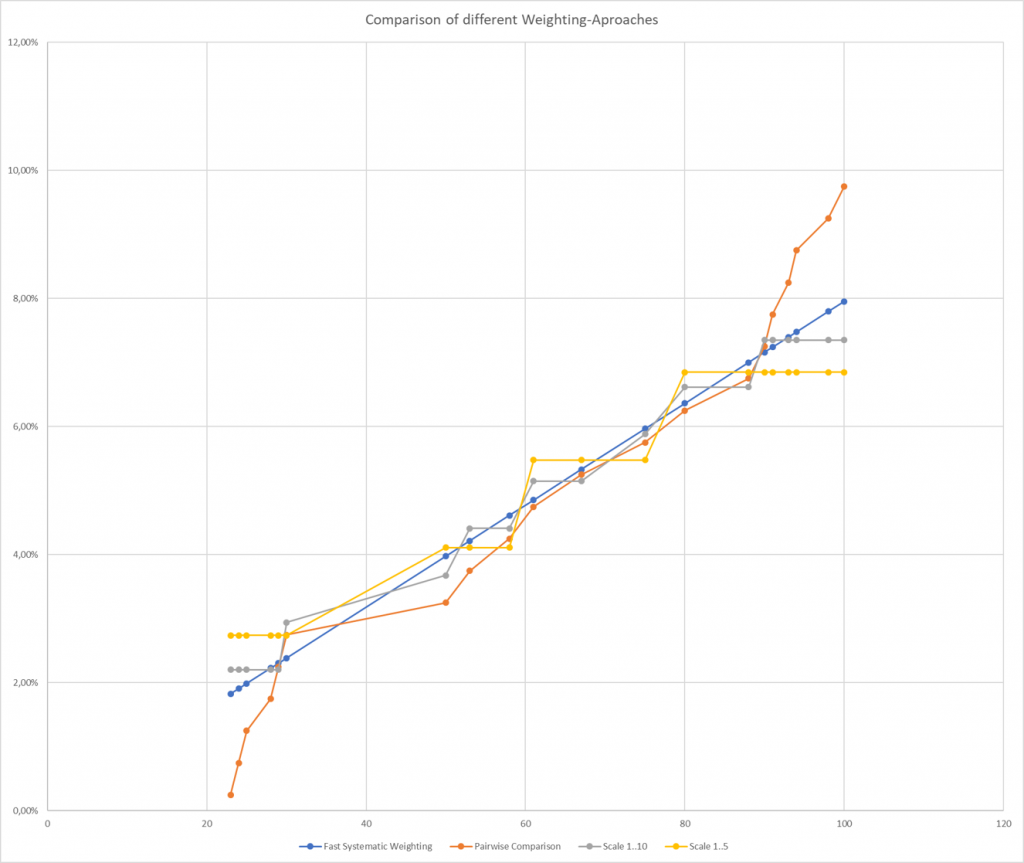FSW - Fast Systematic Weighting
For making systematic and objectified decisions, the criteria should be clear and weighted. Their different relevance will affect the decision.
To weight criteria there are several methods and approaches. Familiar are i.e.:
- the „Pairwise Comparison“,
- the „Analytical Hierarchical Process“ (Prof. Saaty) and
- simple giving points for each criterion on a scale, usually 1..3, 1..5 or 1..10.
The Pairwise Comparison as well as the Analytical Hierarchical Process are very time consuming, because every criterion needs to be compared with every other criteria. The „Improved Pairwise Comparison“ is an optimized, work reduced approach of the Pairwise Comparison that has been developed in 2012 by Dr.-Ing. Marc Oellrich. Where the amount of necessary decisions is dramatically reduced.
The special advantage of the Analytical Hierarchical Process is, that inconsistencies during the process get transparent and visible.
All named methods and approaches have one serious disadvantage: They all are not able to represent the reality! And that also for „simple“ criteria.
A small example:
Supposed there are 20 criteria that should be weighted. Instead of criteria there are different amounts of money. Their weighting should be similar to its value (s. table 1).

The discrepancy between the different weighting methods is displayed in the following diagram. The methods, due to their approaches and scales, are only partly able to get a correct weighting.
Displayed is also the characteristic curve of the „Fast Systematic Weighting“, with which it is also possible to get and to show the correct weighting. In this case the correct weighting is equal to the share of the criterion-value to the total sum. The characteristic curve is in this case a streight line.
Not diagrammed is the Analytical Hierarchical Process. Its evaluation is similar to the one of the Pairwise Comparison. The Pairwise Comparison has, due to its method, frequent and in parts dramatical gaps from the correct weighting. The weighting methods „Scale 1..10“ (grey) and „Scale 1..5“ have scale-based discrete steps, which results in stages, which means that their weights are most often above or below the correct weighting.

The Diagram shows, that it is important, to get the correct Weighting. Only this way it can be aedequate and transparent considered in decisions. With the „Fast Systematic Weighting“ this is simple and possible.
How works the "Fast Systematic Weighting"?
The Fast Systematic Weighting works in two steps:
- (Improved) Pairwise Comparison
- Scale and relative Positioning of the criteria
1. The Pairwise Comparison advantageously is done with the concept of the „Improved Pairwise Comparison“, to minimize the necessary compare-decisions. One way to do this, is to add the criteria one by one to a (sorted) list. At first this list is empty. Every further criterion needs to get sorted in. Like the „Quicksort“-algorithm, it can be checked first, if the criterion to add is more or less important than the one, which is in the middle of the sorted list. Afterwards it is than respectively checked against the middle of the remaining half (of the list), until the criterion is placed. With this approach, the criterion does not have to be compared to all others (which is the big advantage of this approach). Sorting the criteria one by one means also, that the list is consistent.
2. Afterwards the Scale must be specified. That means, to choose for the most unimportant and the most important criteria of the previous Pairwise Comparison, the scale-values. They do not have to start at 1, they could also start i.e. at 21 and could end with 21, but also at 100, 1000 or any other number.
Then, analog to the described sorting procedure (s. 1), the relative Position of each criterion must be specified. Where to put the middle criterion (Middle) of the sorted list, relative between the most unimportant (Bottom) and the most important (Top) criterion? Afterwards appropriate for the top and the bottom half of the list. Where to put the middle criterion of the top half relative between the Middle- and the Top-criterion? And so on…
With this relative-positioning the allocation gets selective distorted, to get as near as possible to the „correct“ Weighting.
If you want to, we can send you the Excel-Macrofile, that will support this approach. You have to type or copy in the criteria and the macro helps you comfortably with the sorting and the following relative-positioning.